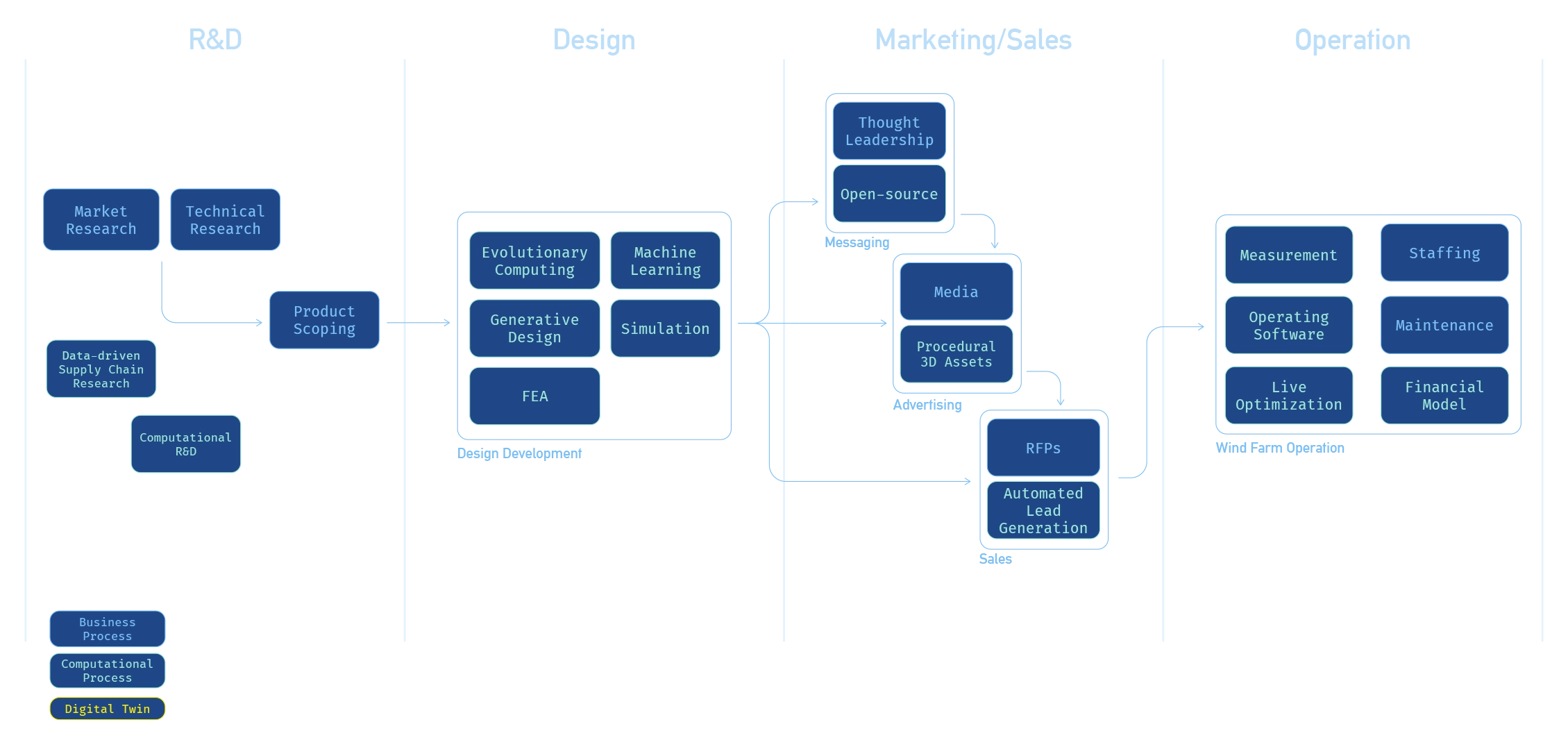
From bridges and buildings to electronics and transport,
This article proposes extending a digital twin across an entire organization, in order to unlock more insights, better communication, and a stronger culture of organizational intelligence.
Digital twins today
To begin with, let’s imagine a real-world example: the product pipeline of a company that makes wind turbines:
 Product pipeline for wind turbines
Product pipeline for wind turbines In the company’s product and manufacturing units, we can expect to find tools such as
Simscale: Finite Element Analysis
These computational methods will often be connected by digital twins: 3D representations of live data, most commonly tailored for use in design and operational processes.
 Digital twins used in the product pipeline
Digital twins used in the product pipeline In the design process, these digital twins might visualize, measure, and compare potential solutions to wind-turbine design problems. In operational contexts, they could be monitoring and managing real-world wind farms, and collecting data from performance tests that can be used to inform future design development.
Depending on the organization, some or all of this tooling may belong to different teams, with consistency enforced to streamline data transfer between them:

This approach has its advantages:
- Features can be developed and tested in isolation, and merged upstream when they are ready
- By keeping things specialist and modular, we can easily set data permissions: our wind-farm operators don’t need the design tooling, and our designer team doesn’t need a live feed of energy generation data.
- We can specify custom digital twins for different user groups that have the precise functionality we need.
Digital twins are most commonly employed in 3D, physical use cases like our wind-farm, but similar computational processes are taking place all throughout an organization.
Organization-wide computation
Consider the other areas of the organization where computation is commonly used.

- A technical team uses to ensure stability when deploying the software that controls our turbinesCI/CDContinuous Integration / Continuous Deployment is an automation of the build and testing steps required for deploying an application. CI/CD pipelines ensure that production code remains reliable.
- A sales team uses data-driven marketing techniques to generate new business leads
- A research team working on business development uses geospatial analysis to identify sites for future wind farms
It’s rare for these systems to fully connect, but when they do, they can reveal powerful insights and opportunities.
A Unified approach
What if we built a digital twin of our entire organization?

By taking a system-wide approach, we can build a live repository of tooling and data for our entire organization. Carefully managed permission systems protect sensitive information, and unlock three key areas of value:
Leaders can make more informed decisions.
Are our wind-turbine company’s resources being used effectively? Maybe a new computational design process has lowered costs, and opened up some resource that could be used for a new research project. More visibility means more informed decision-makers, and better decisions.
Teams can unlock insight, efficiency, and opportunities.
When teams are exposed to the innovation happening throughout the whole organization, new opportunities are revealed.
- Could our new business team leverage the innovative site analysis of the GIS team when looking for new sites?
- What if the sales team could show customers the performance/cost tradeoffs with animations from the generative design process?
Live, visual insights into the work of other teams makes it possible to spot and evaluate these opportunities.
Computational workflows create compounding returns
As more and more organizations undertake digital transformation and integrate AI, we can expect to see a resulting compounding effect. In particular, the ever-increasing fine-tuning and customization capabilities of language models can unlock huge compounding opportunities for organizations with strong, holistic data infrastructure.
Closing Thoughts
Building a unified digital twin of an organization is a complex challenge. It requires both technical infrastructure, and a carefully considered design strategy that encourages sharing while maintaining confidentiality.
The upsides can be profound across all business processes - and we can only expect them to become more powerful and nuanced as technology progresses further.
Organizations interested in partnering with Crossground on digital twins of any kind are encouraged to reach out at